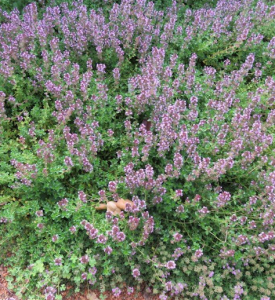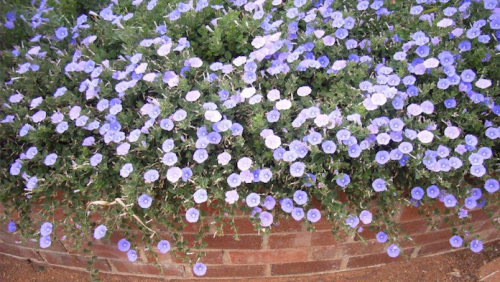
MULCH, mulch, mulch… that’s the constant message with our extreme evaporation rate that starts in late spring and lasts to late autumn.
Besides the many varieties of regular mulch, there are alternatives such as possibly the most effective mulch of all – “living mulches”. While it’s not the time to plant living mulches, it is a good opportunity to prepare the ground for them.

Living mulches that are easy to maintain and provide colour in the garden, include the prostrate varieties of the Thymus family, commonly referred to as carpet or creeping thymes.
Pictured are just two examples in our garden now in flower. There are many other creeping thymes such as T. “Orange Peel” T. “Jekka” and T. “Silver Posy”. When buying carpet thymes it is possibly cheaper to buy a single 140-150mm pot and cut the thyme into three or four sections like a cake, rather than buying three or four 100mm pots.
As the carpet thymes spread, it is easy to cut out sections with a sharp knife and transplant to other bare areas in the garden. I could divide our carpet thymes to produce at least 100 extra plants. Once established you will never need to buy another thyme.

Almost all thymes are from Europe and the Mediterranean region, tolerating extreme heat and not concerned with the cold. Good drainage is essential, so if you have heavy clay type soil mix in coarse, washed river sand (not builders’ sand).
Other prostrate ground covering plants ideal for a living mulch include the canescens variety of the Phyla nodiflora. It spreads rapidly by means of its lateral stems that root on contact with the soil to about a metre wide and five to 10 millimetres high with scented, small, pinkish-white flowers through late summer and autumn. The flowers are a good source of honey. For larger areas Rosmarinus officinalis prostratus with the lateral stems growing with lateral shoots similar to Phyla. Growing on the top of a wall, this rosemary will hang down presenting a floral image of blue flowers. Plus it can also be used for cooking.
Viola labradorica is an absolute delight with small, violet flowers late summer to autumn and mauve-tinged leaves growing to about 10 centimetres. Originating from Labrador to Alaska, despite its origins, this grows very well in Canberra.
Then there’s the Australian Pratia pedunculata, a prostrate creeping plant with tiny, round leaves with light blue or white flowers, growing to about two centimetres tall.
This is just a small selection of evergreen ground covers which, with the exception of the rosemary, are ideal for small areas, such as courtyards, although our carpet thymes have now spread to one metre by two metres wide.

Finally, for a floral display from spring to late summer, look for the range of Convolvulus. C. “Moroccan Beauty” gives the clue to its origin. Growing in straight sand in the heat of the desert, it is ideal for our heat. It spreads easily to two metres with a height of just 10 centimetres.
Jottings…
- Carry out a summer prune of excess growth on apples and pears.
- If English lavender has finished flowering, cut back the flower heads, but not into the old growth.
- Don’t over water in the extreme heat. For dripper systems if the temperature is up to 25C-30C, it only needs to run for an hour once a week. When temperatures exceed this, increase the time to two hours once a week. Container plants will need watering every couple of days.
Who can be trusted?
In a world of spin and confusion, there’s never been a more important time to support independent journalism in Canberra.
If you trust our work online and want to enforce the power of independent voices, I invite you to make a small contribution.
Every dollar of support is invested back into our journalism to help keep citynews.com.au strong and free.
Thank you,
Ian Meikle, editor




Leave a Reply